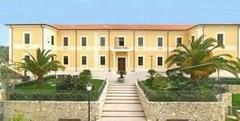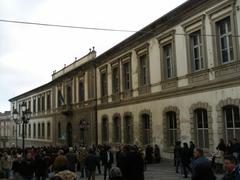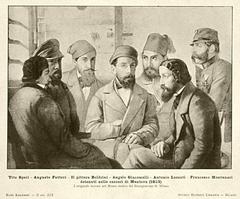Castello di Squillace: Visiting Hours, Tickets, and Historical Significance
Date: 24/07/2024
Introduction
Nestled on the highest point of the hill in Squillace, Catanzaro, Italy, the Castello di Squillace is a historical monument that offers a fascinating journey through centuries of history. The castle, with its rich past dating back to the 11th century, has witnessed significant historical events and transitions of power, from the Norman conquest of Calabria to its role in the Napoleonic era (Calabria Straordinaria). This comprehensive guide aims to provide visitors with an in-depth understanding of the castle’s historical significance, architectural marvels, and practical visitor information, including ticket prices, visiting hours, and travel tips. As a site of architectural and archaeological wonders, Castello di Squillace attracts history enthusiasts, architecture buffs, and casual travelers alike. From its Norman origins and Byzantine foundations to the influence of the Borgia family and its eventual use as a prison, the castle’s storied past is a testament to the region’s rich and diverse history (My Bella Vita). Whether you are exploring the polygonal tower built under Frederick II or the late Roman necropolis unearthed during recent excavations, Castello di Squillace promises a memorable and educational experience for all visitors.
Table of Contents
- Introduction
- Historical Overview
- Norman Origins and Byzantine Foundations
- Medieval Developments and the Borgia Influence
- Architectural and Archaeological Significance
- The Castle as a Political and Military Stronghold
- The Borgia Era and Subsequent Ownership
- The Castle’s Role in the Napoleonic Era
- Modern Discoveries and Preservation Efforts
- Visitor Information
- FAQ
- Conclusion
- Sources
Historical Overview
Norman Origins and Byzantine Foundations
The Castello di Squillace has a rich history, dating back to the second half of the 11th century when it was constructed by the Normans after their conquest of Calabria from the Byzantines (Calabria Straordinaria). Under Ruggero d’Altavilla, Squillace became a significant administrative, political, and religious center, leading to the establishment of the Carthusian Monastery of Serra San Bruno.
Medieval Developments and the Borgia Influence
Originally built on the ruins of a Byzantine monastery, the castle saw significant changes under various ruling families, notably the Borgia family, who governed Squillace from 1494 to 1735 (My Bella Vita). They constructed a large palace, although it was never completed.
Architectural and Archaeological Significance
The castle’s architecture, including the polygonal tower on the east side likely constructed under Frederick II, reflects its tumultuous history. Archaeological excavations in 2008 uncovered a late Roman necropolis beneath the Norman castle, revealing 22 graves with rich grave goods (Calabria Straordinaria).
The Castle as a Political and Military Stronghold
Throughout its history, the Castello di Squillace has been a focal point of political and military activity. Significant fortifications were constructed in the early 13th century, including the polygonal tower. The castle’s strategic importance continued under the Anjou dynasty.
The Borgia Era and Subsequent Ownership
The Borgia family’s influence began in 1494 through marriage alliances. The castle remained under their control until 1729 and later came under the ownership of the De Gregorio family until a devastating earthquake in 1783 (Calabria Straordinaria).
The Castle’s Role in the Napoleonic Era
Despite severe damage from an earthquake in 1793, King Giuseppe Bonaparte repurposed the castle as a prison, a function it served until 1978 (My Bella Vita).
Modern Discoveries and Preservation Efforts
Recent archaeological efforts have unearthed significant findings, including a late Roman necropolis, providing valuable insights into the castle’s historical context and the social status of its ancient inhabitants (Calabria Straordinaria).
Visitor Information
Visiting Hours and Tickets
The Castello di Squillace is open to visitors year-round. Typical visiting hours are:
- Monday to Friday: 9:00 AM - 6:00 PM
- Saturday and Sunday: 10:00 AM - 7:00 PM
Tickets:
- Adult: €8
- Children (ages 6-12): €4
- Seniors (65+): €6
- Free entry for children under 6
Tickets can be purchased at the entrance or online through the official website.
How to Get There
The castle is accessible via winding medieval streets that lead to the top of the town. Public transportation options and parking facilities are available nearby.
What to See
Visitors can explore various sections of the castle, including the polygonal tower and remnants of the Borgia palace. The archaeological findings, such as the late Roman necropolis, offer a fascinating glimpse into the past.
Special Events and Guided Tours
Check for special events and guided tours that may be available during your visit. These often provide deeper insights into the castle’s history and significance.
Photographic Spots
The castle offers numerous photographic opportunities, with panoramic views of the valley below and its historic architecture providing stunning backdrops.
FAQ
What are the visiting hours for Castello di Squillace?
Visiting hours vary by season. It is best to check the official website or contact the local tourism office for the latest information.
How much are tickets for Castello di Squillace?
Ticket prices can vary. Refer to the official website or local tourism office for current pricing.
Are guided tours available?
Yes, guided tours are available in multiple languages and can be booked in advance.
What should I wear when visiting Castello di Squillace?
Wear comfortable footwear and dress according to the weather, as parts of the castle are exposed to the elements.
Can I take photos at Castello di Squillace?
Yes, photography is allowed, but using drones requires special permission.
Conclusion
The Castello di Squillace stands as a monumental testament to the rich historical tapestry of the region. Its architectural features, ranging from Norman military structures to Byzantine influences, offer a unique glimpse into the past. The castle’s role as a political and military stronghold, along with its subsequent transformations under various ruling families, underscores its historical significance. Today, the castle continues to captivate visitors with its archaeological discoveries and well-preserved structures. Whether you are a history enthusiast, an architecture aficionado, or a casual traveler, a visit to Castello di Squillace promises to be a memorable journey through time. By exploring its well-preserved remains and participating in guided tours, visitors can gain a deeper appreciation of the castle’s historical, cultural, and architectural importance. For the latest updates, events, and visitor information, be sure to check the official website or follow local tourism updates (Calabria Region Tourism and Commerce Department).
Sources
- Calabria Straordinaria. (n.d.). Norman Castle of Squillace. Retrieved from Calabria Straordinaria.
- My Bella Vita. (n.d.). The Mysterious History of Squillace Castle. Retrieved from My Bella Vita.
- Comune di Squillace. (n.d.). Castello di Squillace. Retrieved from Comune di Squillace.
- Encyclopedia Britannica. (n.d.). Norman Architecture. Retrieved from Encyclopedia Britannica.
- Academia.edu. (n.d.). Byzantine Influence on Italian Architecture. Retrieved from Academia.edu.
- Calabria Tourism. (n.d.). Cultural Events at Castello di Squillace. Retrieved from Calabria Tourism.
- World Tourism Organization. (n.d.). Economic Impact of Tourism. Retrieved from World Tourism Organization.
- UNESCO. (n.d.). Sustainable Restoration Practices. Retrieved from UNESCO.



